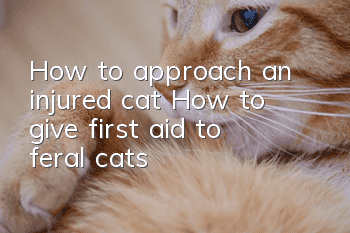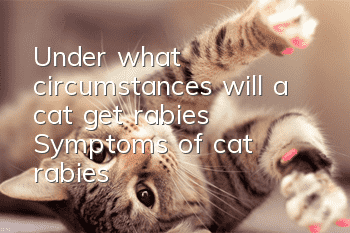How to approach an injured cat? How to give first aid to feral cats

Cats living in the wild and traveling through the human world are likely to suffer various injuries, such as being hit by a car, eating rat poison, and eating spoiled food, which may cause injuries and shock to the cat. In this case, you can contact the injured cat and provide first aid according to the following points.
1. How to approach an injured cat
To successfully approach an injured cat, you must remember and always pay attention to the cat’s five weapons—the mouth and four sharp and flexible claws. An injured cat is likely to be frightened at the same time, especially if you approach the cat when you are cornering it in a blind corner. You must pay extra attention and approach the injured cat very carefully and slowly. After all, you are trying to assist a frightened cat that may have been scratched or bitten. It may attack out of extreme fear, but just pay attention to the cat's state, including eyes, posture, voice, movements, and correct It is also very easy to understand and approach it in an appropriate and effective way.
Here’s how to approach an injured cat;
1. Approach the cat with slow movements and use a calming voice or soft words to soothe it.
2. Approach the cat slowly but not close to it.
3. Keep a distance and lean down to face the cat. While continuing to speak softly to it, observe the cat’s eyes and body language: If the cat’s eyes are wide open, its ears are back, and it is emitting sounds from its throat. If the cat makes a low growl or hiss, please do not try to pet it; if the cat is trembling, squatting, and curling up its limbs, you can slowly try to pet it to soothe it, starting from the part where the head is connected to the back, if it allows you In doing so, you can gently scratch the cat's head and other parts of the neck, slowly scratch the ears and stroke the chin to make the cat feel comfortable, calm and settled.
2. How to perform cardiac resuscitation on cats
If the cat has no heartbeat, cardiopulmonary resuscitation (CPR) can be performed.
Lay the cat on its side; the rescuer kneels down near its head; grasp the cat's ribcage so that the sternum rests in your palm, using your thumb and fingers to grasp one side , the grasping position should be in the middle of the chest; grasp the fingers together to squeeze the chest, the frequency is 100 to 160 times per minute; after 30 seconds, while squeezing the chest, use the other hand to squeeze the cat's mouth Close your head tightly and blow air into its nostrils. Blow for 3 seconds, then take a deep breath, and repeat the cycle until you feel resistance or see the chest expand. Repeat this action 10 to 20 times per minute; stop after one minute and check for breathing movement in the cat's chest. Place your fingers one inch behind the cat's elbow.Feel the heartbeat in the center of the chest; if the cat still has no heartbeat, continue CPR.
3. How to perform artificial respiration for cats?
Have the cat lie on its side; stretch its head and neck, keeping its mouth closed, and then blow air into its nostrils. Control each breath for 3-5 seconds, and repeat this process until you feel resistance or see its chest bulging; stop after 10 seconds and check its chest. If the chest rises and falls naturally, the cat has been able to start on its own. Breathe; if the cat is still not breathing, continue artificial respiration; take the cat to the veterinarian immediately and continue artificial respiration during transportation until the cat can begin to breathe on its own without help.
When approaching an injured cat, you must first ensure your personal safety and avoid being scratched or bitten by a small wild cat. If you are injured by a cat, you must clean the wound in time and get some vaccinations if necessary.
- Should cats wear a collar for external deworming?
- How to wean a kitten Scientific weaning strategy
- Distinguish between folded and false ears
- Can the cat be hungry?
- Can Chinese garden cats eat oranges?
- Can cats eat canned cat food?
- Can cats eat puff cream?
- Will a cat die if he eats some ice cream?
- Is Fengyoujing harmful to cats?
- Can cats eat human cold medicine?



